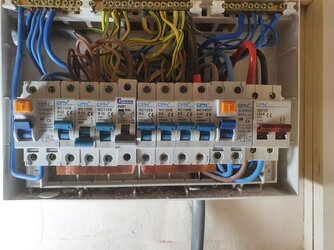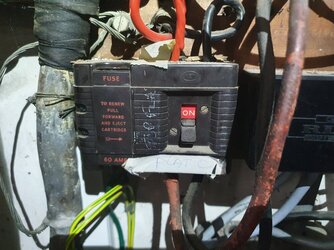- Jun 29, 2020
- 1,752
- 2,506
- 3,688
- If you're a qualified, trainee, or retired electrician - Which country is it that your work will be / is / was aimed at?
- United Kingdom
- What type of forum member are you?
- Practising Electrician (Qualified - Domestic or Commercial etc)
- Business Name
- Dartlec
Doing an EICR on a top floor flat recently and run into an issue I often do - which is judging imperial sizes when they are larger than the standard 1/1.5/2.5mm equivalents.
In this case, the flat is fed by a Twin and Earth cable that is somewhere around the 10-16mm range equivalent, with an earth that appears to be around the 6mm equivalent, but I'm struggling to tie down exactly what it is to confirm suitability.
Pic attached is of the consumer unit - Circuit 1 is a 10mm t&e shower, The incoming earth is in the far right earth bar connection, next to 2 x 10mm bonding cables.
To my eye, I would put the earth at larger than 4mm, but smaller than 10mm (so 6mm approx). The places I've found that list what sizes were available in Twin and Earth don't quite seem to match up.
The two options for the Twin and Earth I've found in an internet search could be 7/.052 (9.35mm2) for the Live conductors, and 7/0.44 (6.45mm2) for the earth.
However, the Live conductors look a little larger than that, in which case they could be 7/.064 (14.52mm2) and the earth 7/0.52 (9.35mm)
Any experienced people out there who could judge which it is from the picture?
Either way, my calculations suggest the earth would still comply under the adiabatic equation even at 6mm2, though it obviously does have an impact on cable rating for the main incomers. (Currently from a BS88 Fuse isolator that says 60A, but actually has an 80A fuse in it)
Other than having a micrometer on hand to measure the diameter of an individual strand, is there a rule of thumb that works for old cables like this? Based on my experience there are still a lot of them out there in older houses or converted flats, and most of them still seem to have life left in them, unlike the nasty rubber stuff shudder
Any thoughts welcomed from the more experienced among you.
(For clarity, I've noted lots of other things on the EICR that are clear in this picture - the Europa MCB, the possible overload of RCD 2, etc - this post is really about the incomer, but feel free to comment on any other codes you see for interest)

In this case, the flat is fed by a Twin and Earth cable that is somewhere around the 10-16mm range equivalent, with an earth that appears to be around the 6mm equivalent, but I'm struggling to tie down exactly what it is to confirm suitability.
Pic attached is of the consumer unit - Circuit 1 is a 10mm t&e shower, The incoming earth is in the far right earth bar connection, next to 2 x 10mm bonding cables.
To my eye, I would put the earth at larger than 4mm, but smaller than 10mm (so 6mm approx). The places I've found that list what sizes were available in Twin and Earth don't quite seem to match up.
The two options for the Twin and Earth I've found in an internet search could be 7/.052 (9.35mm2) for the Live conductors, and 7/0.44 (6.45mm2) for the earth.
However, the Live conductors look a little larger than that, in which case they could be 7/.064 (14.52mm2) and the earth 7/0.52 (9.35mm)
Any experienced people out there who could judge which it is from the picture?
Either way, my calculations suggest the earth would still comply under the adiabatic equation even at 6mm2, though it obviously does have an impact on cable rating for the main incomers. (Currently from a BS88 Fuse isolator that says 60A, but actually has an 80A fuse in it)
Other than having a micrometer on hand to measure the diameter of an individual strand, is there a rule of thumb that works for old cables like this? Based on my experience there are still a lot of them out there in older houses or converted flats, and most of them still seem to have life left in them, unlike the nasty rubber stuff shudder
Any thoughts welcomed from the more experienced among you.
(For clarity, I've noted lots of other things on the EICR that are clear in this picture - the Europa MCB, the possible overload of RCD 2, etc - this post is really about the incomer, but feel free to comment on any other codes you see for interest)

- TL;DR
- What size is this imperial twin and earth submain cable?




 Not sure if these boards are supposed to have one, but it's often a luxury that isn't supplied in my experience, particularly in flat CUs. In this situation the flat was empty and the CU about 6 inches off the floor in a cupboard, so I have to admit that I didn't put the board cover back on every time while live testing.....
Not sure if these boards are supposed to have one, but it's often a luxury that isn't supplied in my experience, particularly in flat CUs. In this situation the flat was empty and the CU about 6 inches off the floor in a cupboard, so I have to admit that I didn't put the board cover back on every time while live testing.....
![IMG_0276[20835].jpg IMG_0276[20835].jpg](https://electricians.s3.eu-west-1.amazonaws.com/data/attachments/50/50084-b58ab319c043583c293a46e050af6d1b.jpg?hash=tYqzGcBDWD)






